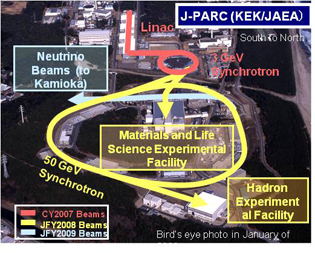J-PARC (Japan Proton Accelerator Research Complex) consists of a series of world-class proton accelerators and the experimental facilities that make use of the high-intensity proton beams. Open to users from around the globe. J-PARC is a multi-purpose and multidisciplinary facility that is unique in the variety of secondary-particle beams produced and put to use in cutting-edge research across a wide range of scientific fields. Neutron, pion, kaon and neutrino beams are all produced at J-PARC via collisions between the proton beams and target materials (spallation reactions). The applications of these beams include fundamental nuclear and particle physics, materials and life science, and nuclear technology.
It is the intensity of the secondary-particle beams that makes J-PARC special. Responding to the ever-increasing demands of modern experiments, the high-intensity makes possible the impossible and unlocks the door to new and exciting research endeavors.
J-PARC has three proton accelerators: a 400 MeV linear accelerator (currently operating at 180 MeV), a 3 GeV rapid-cycling synchrotron (RCS) and a 50 GeV (currently 30 GeV) main ring (MR). In each case, target materials and designs are employed to maximize the efficient production of the desired secondary particle beam.
Though the development schedule of J-PARC was interrupted by the earthquake that struck eastern Japan in March 2011, we expect RCS to achieve the designed full power output of 1 MW in 2015.
|

|
In normal operation mode, over 90% of the protons accelerated in the RCS are directed to the muon and neutron production targets in the Materials and Life Science Experimental Facility (MLF). The remaining protons are transported to the MR for further acceleration before being extracted via one of two MR extraction ports. The slow extraction (SX) port directs the high-energy protons to the Hadron Experimental Facility where a variety of nuclear physics experiments are carried out using K-mesons. Protons from the fast extraction (FX) port are guided by superconducting magnetic array towards the pion production target. Neutrinos generated in pion decay processes are sent as part of the T2K experiment to the Super-Kamiokande facility 300 km west of Tokai in Gifu Prefecture.

|
How to get access to the J-PARC facilities
Each facility at J-PARC operates user access programs that are open to researchers from around the world. Researchers wishing to use J-PARC are requested to submit an experiment proposal with the relevant facility. In each case, proposals are independently reviewed by a committee comprised of members with the appropriate expertise and experience.
The J-PARC Users Office supports the activities of facility users providing assistance with proposal submission and administrative procedures as well as a range of other services and information to help make the J-PARC experience enjoyable and fruitful.
|







